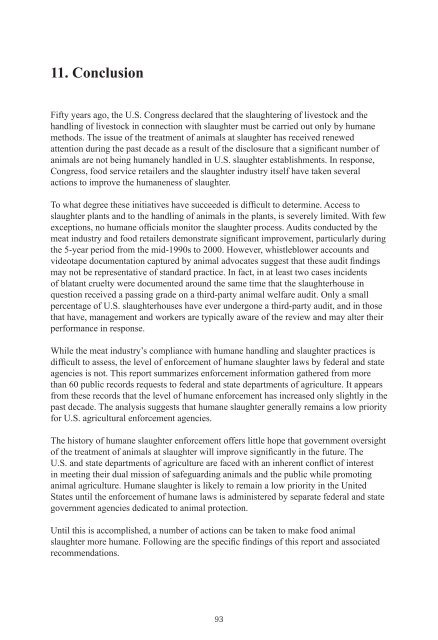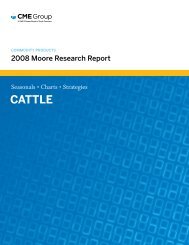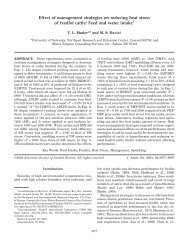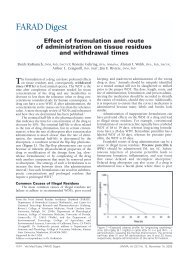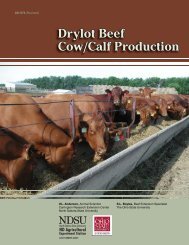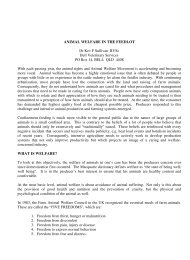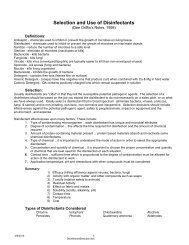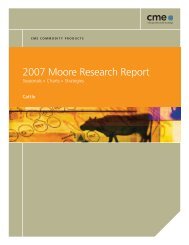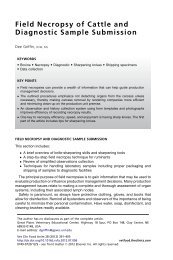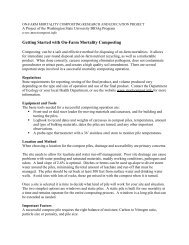CRIMES WITHOUT CONSEQUENCES - gpvec
CRIMES WITHOUT CONSEQUENCES - gpvec
CRIMES WITHOUT CONSEQUENCES - gpvec
Create successful ePaper yourself
Turn your PDF publications into a flip-book with our unique Google optimized e-Paper software.
11. Conclusion<br />
Fifty years ago, the U.S. Congress declared that the slaughtering of livestock and the<br />
handling of livestock in connection with slaughter must be carried out only by humane<br />
methods. The issue of the treatment of animals at slaughter has received renewed<br />
attention during the past decade as a result of the disclosure that a significant number of<br />
animals are not being humanely handled in U.S. slaughter establishments. In response,<br />
Congress, food service retailers and the slaughter industry itself have taken several<br />
actions to improve the humaneness of slaughter.<br />
To what degree these initiatives have succeeded is difficult to determine. Access to<br />
slaughter plants and to the handling of animals in the plants, is severely limited. With few<br />
exceptions, no humane officials monitor the slaughter process. Audits conducted by the<br />
meat industry and food retailers demonstrate significant improvement, particularly during<br />
the 5-year period from the mid-1990s to 2000. However, whistleblower accounts and<br />
videotape documentation captured by animal advocates suggest that these audit findings<br />
may not be representative of standard practice. In fact, in at least two cases incidents<br />
of blatant cruelty were documented around the same time that the slaughterhouse in<br />
question received a passing grade on a third-party animal welfare audit. Only a small<br />
percentage of U.S. slaughterhouses have ever undergone a third-party audit, and in those<br />
that have, management and workers are typically aware of the review and may alter their<br />
performance in response.<br />
While the meat industry’s compliance with humane handling and slaughter practices is<br />
difficult to assess, the level of enforcement of humane slaughter laws by federal and state<br />
agencies is not. This report summarizes enforcement information gathered from more<br />
than 60 public records requests to federal and state departments of agriculture. It appears<br />
from these records that the level of humane enforcement has increased only slightly in the<br />
past decade. The analysis suggests that humane slaughter generally remains a low priority<br />
for U.S. agricultural enforcement agencies.<br />
The history of humane slaughter enforcement offers little hope that government oversight<br />
of the treatment of animals at slaughter will improve significantly in the future. The<br />
U.S. and state departments of agriculture are faced with an inherent conflict of interest<br />
in meeting their dual mission of safeguarding animals and the public while promoting<br />
animal agriculture. Humane slaughter is likely to remain a low priority in the United<br />
States until the enforcement of humane laws is administered by separate federal and state<br />
government agencies dedicated to animal protection.<br />
Until this is accomplished, a number of actions can be taken to make food animal<br />
slaughter more humane. Following are the specific findings of this report and associated<br />
recommendations.<br />
93


